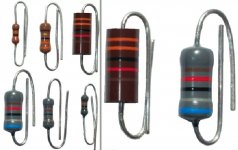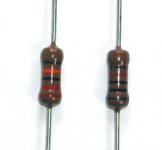Try this:JDeV said:Is it possible to identify a Tantalum resistor from a carbon resistor, or any other type of resistor and if so, how??
http://www.google.be/search?q="Tantalum+resistor&ie=UTF-8&oe=UTF-8&hl=nl&meta=
/Hugo
Re: Re: How to ID Tantalum resistors??
At least found this, but nothing on how to identify
Looks pretty much like any other ol carbon resistor.
The big brown 1 in the pic, would it maybe look like if it is made from a round plastic type of material?
Netlist said:
At least found this, but nothing on how to identify
Looks pretty much like any other ol carbon resistor.
The big brown 1 in the pic, would it maybe look like if it is made from a round plastic type of material?
Attachments
• Metal film resistors are chosen for precision applications where initial accuracy, low temperature coefficient, and lower noise are required. Metal film resistors are generally composed of Nichrome, tin oxide or tantalum nitride, and are available in either a hermetically sealed or molded phenolic body. Typical applications include bridge circuits, RC oscillators and active filters. Initial accuracies range from 0.1 to 1.0 %, with temperature coefficients ranging between 10 and 100 ppm/°C. Standard values range from 10.0 ohms to 301 kohms in discrete increments of 2% (for 0.5% and 1% rated tolerances).
Quote from Analog devices.
So all we can conclude is that all Tantalum R's are metal film but not vice versa.
That's about as far I'm able to ID
/Hugo
Quote from Analog devices.
So all we can conclude is that all Tantalum R's are metal film but not vice versa.
That's about as far I'm able to ID

/Hugo
Refering to the pic...
Hi,
I know nothing of tantalums, but:
The top pair of "dipped" resistors, I would take to be carbon film.
The bottom row, I would take to be metal film.
The "moulded" resistors shown could be composition, though some modern ones I've come across, especially closer tolerance examples, when opened, have turned out to have a cut helix, just like a film resistor.
Cheers,
Hi,
I know nothing of tantalums, but:
The top pair of "dipped" resistors, I would take to be carbon film.
The bottom row, I would take to be metal film.
The "moulded" resistors shown could be composition, though some modern ones I've come across, especially closer tolerance examples, when opened, have turned out to have a cut helix, just like a film resistor.
Cheers,
analog_sa said:There is certainly no way to idetify them by looking - i have brown, grey and purple tants. But it's quite easy to id them by listening - they have very different sound to all other resistors.
Hi Analog_sa,
How do they sound?
Re: Refering to the pic...
I would totally agree with you, if not this:
http://www.hificollective.co.uk/components/resistors.html
The above pictures come from here and they all seem to be named 'Tantalum'. (You can have the larger pic by clicking on the
magnifying glass)
I am a little suspicious however about what's written on the site
and therefore also about the pictures they display.
E.g.: "In many applications a 2 watt resistor sounds much better that it is 1/2 or 1 watt equivalent".
But this of course is a complete different discussion.
/Hugo
dhaen said:
The top pair of "dipped" resistors, I would take to be carbon film.
The bottom row, I would take to be metal film.
The "moulded" resistors shown could be composition, though some modern ones I've come across, especially closer tolerance examples, when opened, have turned out to have a cut helix, just like a film resistor.
I would totally agree with you, if not this:
http://www.hificollective.co.uk/components/resistors.html
The above pictures come from here and they all seem to be named 'Tantalum'. (You can have the larger pic by clicking on the
magnifying glass)
I am a little suspicious however about what's written on the site
and therefore also about the pictures they display.
E.g.: "In many applications a 2 watt resistor sounds much better that it is 1/2 or 1 watt equivalent".
But this of course is a complete different discussion.
/Hugo
Hi,
This is generally true but it won't turn a crappy brand x 1/4W resistor into a fine sounding resistor if subbed for the same brand x 2W version.
All the tants I've seen look different, the ones sourced from Japan often look as if they're hand-made.
The only way ither then listening to them would be to buy them knowing the exact manufacturer's references and knowing what those look like.
And yes, all of them I heard so far did sound noticebly better than other metal films.
Hope this helps,
E.g.: "In many applications a 2 watt resistor sounds much better that it is 1/2 or 1 watt equivalent".
This is generally true but it won't turn a crappy brand x 1/4W resistor into a fine sounding resistor if subbed for the same brand x 2W version.
All the tants I've seen look different, the ones sourced from Japan often look as if they're hand-made.
The only way ither then listening to them would be to buy them knowing the exact manufacturer's references and knowing what those look like.
And yes, all of them I heard so far did sound noticebly better than other metal films.
Hope this helps,
analog_sa said:There is certainly no way to idetify them by looking - i have brown, grey and purple tants. But it's quite easy to id them by listening - they have very different sound to all other resistors.
Where in SA do you buy these creatures?
Where in SA do you buy these creatures
I don't really buy anything in SA - you need to either wait for ages or it's a real ripoff. Some tantalums i bought many years ago from La Maison de'l Audiohile (or someplace along these lines) in Paris. Currently i order from PartsConnexion - they stock magnetic Audio Notes, which although magnetic sound great to me. I really don't think i can tell them apart from the non-magnetic types. With the rand being so incredibly strong it's much cheaper to import.
- Status
- This old topic is closed. If you want to reopen this topic, contact a moderator using the "Report Post" button.
- Home
- Design & Build
- Parts
- How to ID Tantalum resistors??

